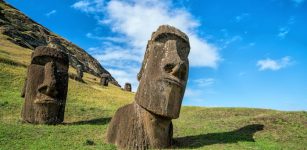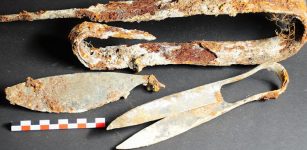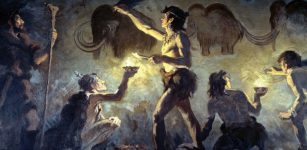Impressive 9,000-Year-Old Stone Mask Uncovered In Southern Hebron Hills, Israel
AncientPages.com - A unique 9,000-year-old stone mask was uncovered several months ago and is currently being studied by experts of the IAA and the Geological Survey of Israel.
The impressive artifact dates to the Neolithic (new stone age) period. It was originally excavated in the Pnei Hever region of southern Har Hevron.

The 9,000-year-old stone mask found in the southern Hebron Hills area of the West Bank in early 2018. Image credit: Israel Antiquities Authority
“The mask is a unique finding in the archaeological world. It is even more unusual that we know which site it came from. The fact that we have information regarding the specific place in which it was discovered makes this mask more important than most other masks from this period that we currently know of,” Ronit Lupu from the IAA Antiquities, said in a press release.
The mask is made of pinkish-yellow limestone, carefully shaped with stone tools to resemble a human face.
Four holes were drilled along the perimeter of the mask, probably in order to tie it – possibly to the face of a living person, or maybe to a pole or other designated artifact in order to display it.
“Discovering a mask made of stone, at such a high level of finish, is very exciting. The stone has been completely smoothed over and the features are perfect and symmetrical, even delineating cheekbones. It has an impressive nose and a mouth with distinct teeth, ” Lupu said.
“Stone masks are linked to the agricultural revolution. The transition from an economy based on hunting and gathering to ancient agriculture and domestication of plants and animals was accompanied by a change in social structure and a sharp increase in ritual-religious activities. Ritual findings from that period include human-shaped figurines, plastered skulls, and stone masks,” Dr. Omry Barzilai, head of the IAA Archaeological Research Department, said.
Ancestor worship was practiced during this period. “It was part of the ritual and retention of family heritage that was accepted at the time,” says Ronit Lupu.
“For example, we find skulls buried under the floors of domestic houses, as well as various methods of shaping and caring for the skulls of the dead. This led to plastering skulls, shaping facial features, and even inserting shells for eyes. Stone masks, such as the one from Pnei Hever, are similar in size to the human face, which is why scholars tend to connect them with such worship.”
AncientPages.com





















